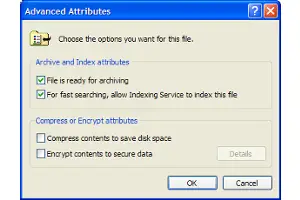Compression and Encryption for File Systems
NTFS v5.0 allows files to be encrypted using the EFS utility (Encrypting File System). Only the person who has encrypted the file and the Recovery Agent can decrypt the file. Encrypted data can’t be moved from one machine to another without first decrypting the data. Compression and Encryption follow the same inheritance rules as NTFS permissions.
Compression is an integral feature of NTFS. It reduces the space a file takes up. The penalty for this is that access times are increased as files need to be uncompressed each time they are opened. (Also, files need sufficient disk space to allow decompression or else they must remain in a compressed state)
Use the buttons below to navigate through the lesson
Right click on any of your files within an NTFS volume and select properties. Select the Advanced button
 This is the window seen when encrypting or compressing a file. The corresponding window for a folder is very similar.
This is the window seen when encrypting or compressing a file. The corresponding window for a folder is very similar.
You cannot Encrypt and Compress a file or folder
Files can also be compressed or encrypted from a command line
These commands can also be used to discover the attributes of objects, or to change the attribute of a particular file type.
Switches for the Cipher command
/e encrypts
/d decrypts
/f forces action
/s:x affects directory x
/s: affects current directory
/q gives no reports
/i ignores error and continues
/file1 file2 file3 (note spaces between multiple files)
/*.txt *.doc *.htm (note use of wildcard)
Switches for Compact command
/c compresses
/u decompresses
/s:x affects directory x
/s: affects current directory
/q gives no reports
/i ignores error and continues
/file1 file2 file3 (note spaces between multiple files)
/*.txt (note use of wildcard)
/f forces action
/a displays hidden or system files